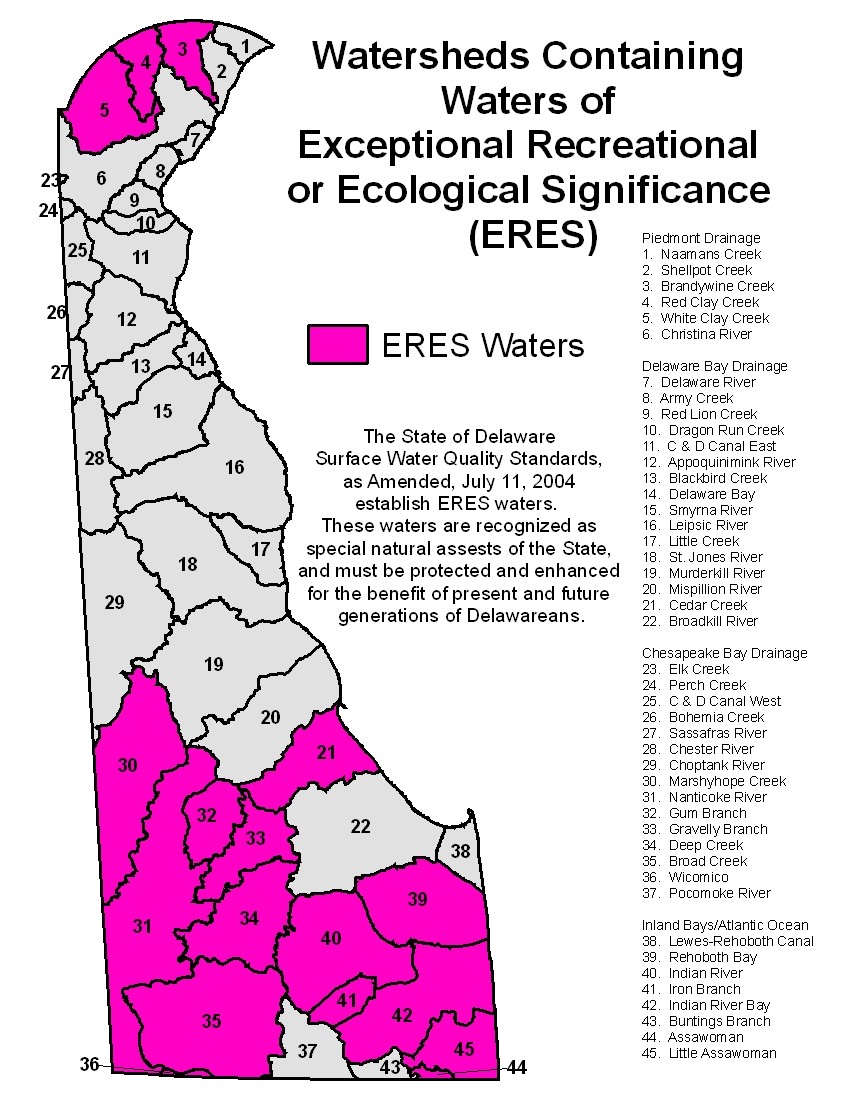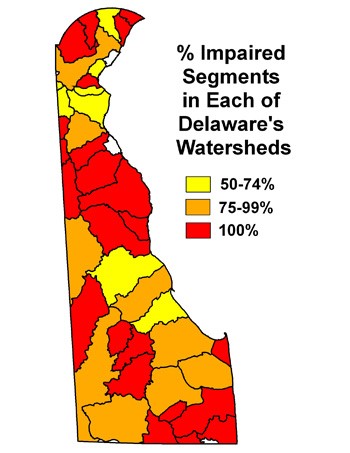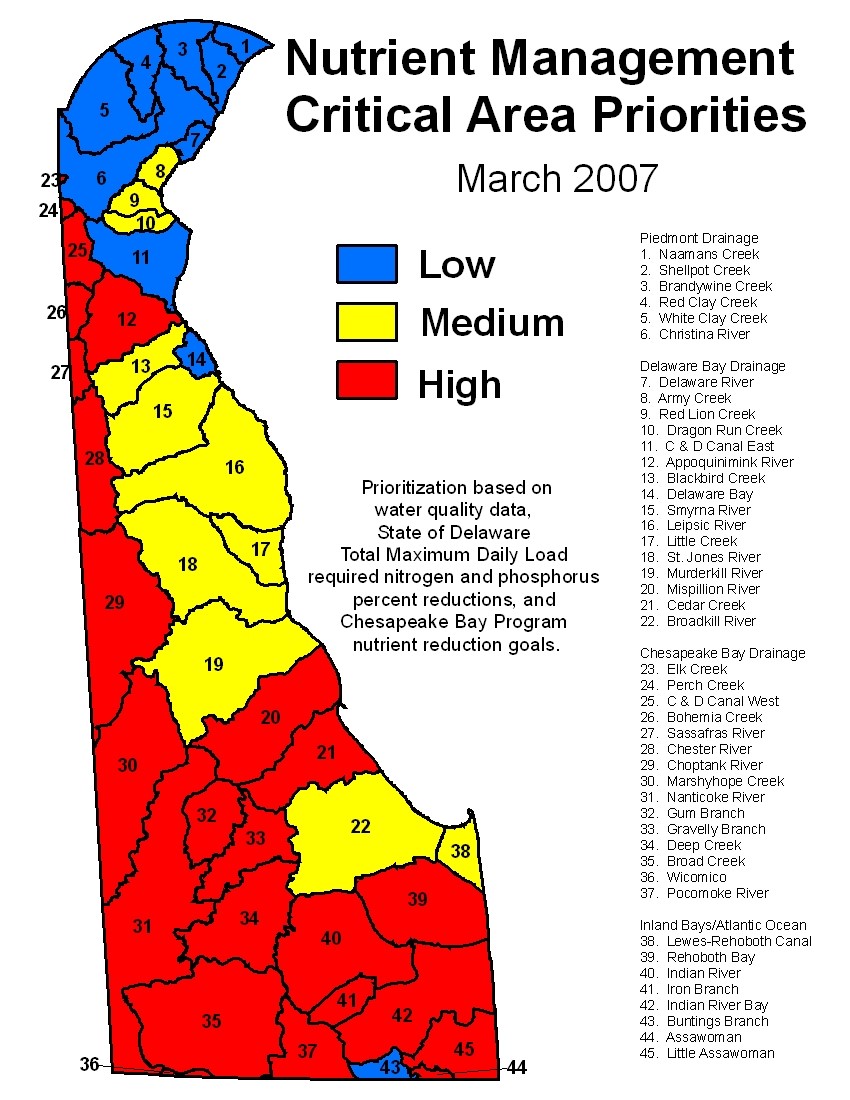
Fact Sheets And Publications

Watersheds: Understanding Total Maximum Daily Loads (TMDLs)
October 2025 | Written by: Jennifer Volk, Ed.D., Environmental Quality Specialist, Associate Director
University of Delaware Cooperative Extension
Introduction
The 1972 Federal Clean Water Act contains a series of requirements for state environmental agencies to protect and restore the quality and health of U.S. waters with the goal of achieving fishable and swimmable status. This fact sheet describes those CWA requirements and how they are implemented in Delaware.
Designated Uses
First, states must specify how they would like to use each waterway. These “designated uses” include recreation, water supply for agriculture or industry, public water supply for human use and drinking water, and to support a variety of aquatic organisms. To protect each use, waters need to meet a certain level of quality.
In Delaware, most waters are designated for primary contact recreation (swimming); secondary contact recreation (wading and boating); industrial water supply; agricultural water supply (freshwaters only); and fish, aquatic life, and wildlife. Only a few of the northernmost rivers in the state are used for public water supply. Several waterways have special designations for certain types of aquatic life, like cold water fish in the northern streams and harvestable shellfish in the Inland Bays to the south. The designation requiring the highest level of protection is for waters that are of “Exceptional Recreation or Ecological Significance” (ERES)(Figure 1). These waterways are important habitats for a multitude of wildlife and are also popular recreation destinations.

Water Quality Standards
Once designated uses have been established, criteria to protect those uses are put into place as water quality standards. The criteria define healthy levels for certain physical, chemical, and biological characteristics, such the amount of dissolved oxygen in the water, which aquatic organisms need to breathe. Criteria can be narrative or numeric.
Since most of Delaware’s waters are designated for fish, aquatic life, and wildlife, they have limits on the pollutants that impact the ability of these organisms to grow and thrive. For example, during the growing season in Delaware’s Inland Bays, an important habitat, inorganic nitrogen must be < 0.14 milligrams per liter (mg/L). In other fresh waters, total nitrogen should be < 3 mg/L. Interestingly, these levels are lower than the national drinking water standard (10 mg/L nitrate), indicating that aquatic organisms are more susceptible to nitrogen pollution than humans.

Watershed Assessment Reports and List of Impaired Waters
The Clean Water Act also requires states to regularly monitor and assess the quality of their waters through a variety of monitoring (water sampling) networks and compare observed levels to the standards. A summary of findings, called a Combined Watershed Assessment Report (305(b) Report) and List of Impaired Waters (303(d) List: ( http://www.udel.edu/0013990) is submitted to the Environmental Protection Agency (EPA) every even-numbered year and is available online to the public.
Section 305(b) of the CWA requires reporting of the conditions of the waters of the State. Section 303(d) of the CWA requires listing of the impaired waters (waters that do not meet their standards). If monitoring reveals that a stream has high pollutant levels that prevent it from achieving all of its designated uses, it is considered impaired and will be placed on the 303(d) list. This information is organized by watershed, or the land area draining to a particular water body.
Since Delaware has a robust monitoring program (https://dnrec.delaware.gov/watershed-stewardship/assessment/water-quality-monitoring/), it has identified that many of our waterways have impairments. The primary pollutants causing these impairments are nutrients (nitrogen and phosphorus) and bacteria.

Total Maximum Daily Loads
When a waterway is placed on the 303(d) list, it triggers another assessment. The assessment determines the sources of the pollutants and how much these pollutants need to be reduced in order to achieve applicable criteria to support the designated uses. What results is called a Total Maximum Daily Load, or TMDL. A TMDL is the maximum daily amount, or load, of a pollutant that can enter a body of water while still meeting water quality standards.
When the criteria are achieved, the designated uses will be supported.
The CWA requires that a TMDL include the following: (1) a Wasteload Allocation (what can come from point sources such as wastewater treatment plants); (2) a Load Allocation (what can come from nonpoint sources like lawns, golf courses, or agricultural fields); and (3) a Margin of Safety.
TMDL = WLA + LA + MOS
Developed using computer models, TMDLS predict how water quality conditions will change with modifications to pollutant inputs and other nutrient management processes on the land, such as installing best management practices (BMPs).
https://www.chesapeakebay.net/what/publications/quick-reference-guide-for-best-management-practices-bmps
In Delaware, TMDLs are promulgated as regulations. By 2006, the Delaware Department of Natural Resources and Environmental Control (DNREC) established TMDLs for the majority of waters within the state that were listed as impaired by nutrients and bacteria. Additionally, TMDLs for other pollutants or harmful conditions like zinc, polychlorinated biphenyls (PCBs), and temperature were established in some parts of the state. In 2010, the EPA also established a TMDL for nitrogen, phosphorus, and sediment for the entire Chesapeake Bay watershed, including the portion of Delaware that drains to the Chesapeake Bay (in these areas, the TMDL that is more stringent supersedes). A complete listing of Delaware TMDLs is maintained on DNREC’s website: (https://dnrec.delaware.gov/watershed-stewardship/assessment/tmdls/) along with their technical support documents and accompanying regulations.
Plans, or TMDL implementation strategies, are developed with stakeholder groups to identify specific reduction activities and timeframes for achieving water quality goals. These documents often focus on actions that reduce pollutants from nonpoint sources, since another portion of the CWA has provisions for addressing pollutant loads from point sources (the National Pollutant Discharge Elimination System (NPDES) permitting process). A list of the implementation plans that have been developed for Delaware’s TMDL watersheds is also maintained on DNREC’s website.
TMDLs and the Nutrient Management Program
The Delaware Nutrient Management Act (Title 3, Chapter 22 of the Delaware Code) (https://delcode.delaware.gov/title3/c022/) was enacted in June 1999 as part of an effort to address water quality concerns in Delaware. One of the factors that led to the drafting of this legislation and ultimately Delaware’s Nutrient Management Program, was the development of TMDLs for several of Delaware’s watersheds and the focus on the agricultural community as one of the primary sources of nutrients.
The Delaware Nutrient Management Program draws on the TMDL process by targeting priority areas for nutrient management activities and tracking water quality improvements from those activities. For more information, see Understanding the Requirements of the Delaware Nutrient Management Law. (https://www.udel.edu/academics/colleges/canr/cooperative-extension/fact-sheets/nutrient-management-law/)
Nutrient management critical area priorities were established to help the Delaware Nutrient Management Commission decide where to focus their efforts with respect to their Nutrient Management Planning and Nutrient Relocation programs. These priorities were based on water quality data and TMDL required nutrient reductions.
The Delaware Nutrient Management Program, in collaboration with partners, uses water quality monitoring data to assess the impacts of its programs and initiatives. This data helps to inform whether new focus areas or actions are needed and quantifies progress already being made.
About the Author
Jennifer Volk (corresponding author), Associate Director, University of Delaware Cooperative Extension, Dover, DE (jennvolk@udel.edu)
About this Publication
Revision date(s): October 2014, August 2025
Adapted from original publications by Dave Hansen, circa 2002
Peer Reviewers
Bhanu Paudel, Delaware Department of Natural Resources and Environmental Control, Dover, DE, 2025
References
EPA, Environmental Protection Agency, www.epa.gov/laws-regulations/summary-clean-water-act
“Integrated Report: 305(B) Report and 303(D) List.” DNREC, 4 Apr. 2025, dnrec.delaware.gov/watershed-stewardship/assessment/reports/#:~:text=Watershed%20Assessment%20and%20Managment%20Section&text=The%20305(b)%20reports%20and,of%20their%20own%20to%20Congress
“Water Quality Monitoring.” DNREC, 5 Feb. 2025, dnrec.delaware.gov/watershed-stewardship/assessment/water-quality-monitoring/
“Quick Reference Guide for Best Management Practices (Bmps).” Chesapeake Bay Program, www.chesapeakebay.net/what/publications/quick-reference-guide-for-best-management-practices-bmps
“Total Maximum Daily Loads and Advance Restoration Plans.” DNREC, 5 June 2025, dnrec.delaware.gov/watershed-stewardship/assessment/tmdls/
“Watershed Plans and Strategies.” DNREC, 3 Nov. 2023, dnrec.delaware.gov/watershed-stewardship/assessment/plans-and-strategies/
Legislature, Delaware. “The Delaware Code Online.” Delaware Code Online, delcode.delaware.gov/title3/c022/
“Delaware Nutrient Management Law: Cooperative Extension: University of Delaware.” Delaware Nutrient Management Law | Cooperative Extension | University of Delaware, www.udel.edu/academics/colleges/canr/cooperative-extension/fact-sheets/nutrient-management-law/
UD Cooperative Extension
This institution is an equal opportunity provider.
In accordance with Federal law and U.S. Department of Agriculture policy, Cooperative Extension is prohibited from discriminating on the basis of race, color, national origin, sex, age, or disability.
